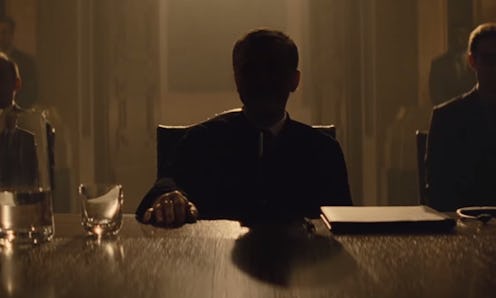
The new James Bond movie, Spectre, arrives in theaters on Nov. 6 and promises to be Daniel Craig's most challenging time yet playing the suave secret agent. After losing the love of his life in Casino Royale, pursuing her killers in the vengeful Quantum of Solace, and facing his mentor M's past (and losing her along the way) in Skyfall, Bond will finally encounter the secret organization at the heart of it all: SPECTRE. But just what is SPECTRE anyway?
SPECTRE is a secret, widespread criminal organization that originally stood for Special Executive for Counter-intelligence, Terrorism, Revenge, and Extortion. So in case you couldn't tell by the name, they're bad guys. Their roots go back to the early 1960s, which isn't too surprising considering how hot spy-related acronyms (like U.N.C.L.E.) were back then. SPECTRE's first appearance came in James Bond creator Ian Fleming's 1961 novel Thunderball. However, the organization wasn't created entirely by Fleming. In 1959, Fleming co-wrote a screenplay with screenwriter Kevin McClory called Longitude 79, with the intention of having it become the first Bond movie. Instead, that honor went to Fleming's already existing novel Dr. No, and Fleming later turned the failed screenplay into Thunderball, incorporating SPECTRE and its leader, Ernst Stravo Blofeld, into the story. SPECTRE then made its way into Bond films where it didn't appear in the corresponding books, starting with Dr. No in 1962, and McClory noticed.
The screenwriter sued Fleming and Bond producers MGM, claiming that SPECTRE and Blofeld were his creations. The two parties settled in 1963, allowing MGM to keep using SPECTRE and Blofeld in its movies for 10 years, at which point the rights would revert back to McClory. And that's what happened. SPECTRE made its last official Bond appearance in 1971's Diamonds Are Forever, and McClory made his own Bond movie (a remake of Thunderball) in 1983 with Never Say Never Again. The two parties remained contentious until 2013, when McClory's estate finally granted the full rights to SPECTRE and Blofeld back to MGM and the Bond franchise.
That's where Spectre comes in. The new movie features the return of the evil organization after a 44-year hiatus, and retcons the Craig Bond movies to make the organization Quantum an offshoot of SPECTRE. Spectre is bringing back the octopus logo, the memorable henchmen (Dave Bautista's Mr. Hinx), and there are even rumors that Christoph Waltz's villain, SPECTRE head Franz Oberhauser, is actually Blofeld. So to prepare for SPECTRE's evil return, here are the other times the organization has popped up to antagonize James Bond over the years.
Dr. No (1962)
The first Bond movie replaces Russian organization SMERSH from the novel with the global SPECTRE in what would become standard procedure for the '60s films. The film's main bad guy, Dr. No, is a SPECTRE underling who attempts to interrupt a U.S. space launch to seed international unrest. He also has a thing for Nehru jackets, which is a classic SPECTRE trait later popularized by Blofeld, and soon, Oberhauser.
From Russia With Love (1963)
SPECTRE pits the British and the Russians against each other by playing both sides in the second Bond movie. It also features the debut of white cat-stroking Blofeld, though his face is never shown.
Thunderball (1965)
Emilio Largo, better known as Number Two, is the main villain in this film where SPECTRE steals two nuclear bombs from NATO and holds them for ransom. The eyepatch-wearing Number Two was later directly parodied in the Austin Powers series by... the eyepatch-wearing Number Two.
You Only Live Twice (1967)
Blofeld is finally revealed in this film, in what is without a doubt the most iconic version of the character. Donald Pleasence's bald, scar-faced performance has been parodied countless times, most notably by Dr. Evil, and remains the benchmark for movie supervillainy.
On Her Majesty's Secret Service (1969)
Sean Connery took a break from being Bond for this entry, which features the only appearance of George Lazenby in the role, but SPECTRE are once again the bad guys. This time, Blofeld (now played by the far less-cartoony Telly Savalas) plans to eradicate the world's entire food supply — permanently. Told you these guys were evil.
Diamonds Are Forever (1971)
Connery returned for his last official (but not actually last) performance as Bond, and though SPECTRE is never mentioned by name, Blofeld is the main antagonist. This time the villain, played by Charles Gray, plans to build a giant laser with stolen diamonds. If that doesn't give you an idea of what this organization is all about, then I don't know what will.
For Your Eyes Only (1981)
It had been years since MGM could legally use SPECTRE or Blofeld by this point, but that didn't stop them from having Roger Moore's Bond kill him (credited as "bald villain in wheelchair) in the opening of the film. Maybe they did it as a way to announce they were done with SPECTRE (10 years after its last appearance), or maybe they just wanted to stick it to McClory. Whatever the reason, they did it.
Never Say Never Again (1983)
This remake of Thunderball was produced by McClory, who somehow convinced Connery to return in the lead role. It didn't quite reach the heights of its previous version though, considering that Connery, who always looked older than his age, was now 52 years old and looking especially ridiculous hooking up with women half his age (and playing '80s video games). The film's title is a reference to the actor's previous insistence that he would never play the character again, and was supposedly christened by his wife.
It's great to see SPECTRE return to face James Bond in Spectre after so many years away, and all signs point to Waltz giving the best villain performance in a Bond movie since Pleasence, whether he's Blofeld or not. So welcome back, SPECTRE. Bond fans have missed you.
Images: MGM Pictures/Columbia Pictures, giphy